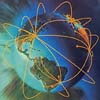 |
Delft, Holland (SPX) Jan 03, 2007 The proper processing of acoustic noise can provide a wealth of information. Geophysicists have used seismic background noise measurements to reconstruct the crustal structure under Southern California. The advantage of using existing acoustic noise is that signals only need to be recorded and not produced. Researchers at TU Delft and the Colorado School of Mines have generalised the underlying theory and found that acoustic noise can be used for a much wider scale of physical applications than was previously thought possible. The researchers will publish their findings in Physical Review Letters on 8 December 2006. As acoustic noise travels through a medium, such as the earth's crust, it compiles information. In recent years it was discovered that only a few simple processes (cross-correlation) were needed to extract a meaningful signal from acoustic noise. Geophysicists Kees Wapenaar and Evert Slob of TU Delft, and Roel Snieder of the Colorado School of Mines, have now developed a unified theory that extends the extraction of impulse responses from background noise for more general situations. This theory includes electromagnetic noise in conducting media, acoustic noise in flowing and viscous media, and even diffusive transport phenomena. Moreover, the theory predicts that coupled processes, such as seismo-electric effect and the associated electrokinetic reflections, can also be retrieved from the background noise measurements. It appears that background noise contains more information than one could possibly dream of several years ago. The theory can be used for 'remote sensing without a source' for a wide range of physical applications that include the determination of parameters of flowing media, viscous media, as well as the electrokinetic coupling parameters of porous reservoir rock. In partnership with Shell, the researchers have since created seismic reflection data from background noise that was recorded in a desert in the Middle East. Moreover, they expect their research methods to be applied in, for example, the LOFAR-project. Related Links Delft University of Technology When the Earth Quakes Dirt, rocks and all the stuff we stand on firmly
 Paris (AFP) Jan 01, 2007
Paris (AFP) Jan 01, 2007The earthquake off Taiwan last Tuesday that shattered Internet connections for millions in Asia demonstrated starkly how vulnerable the vital network is to interruptions. Only a comprehensive backup system in the infrastructure could prevent total paralysis, specialists warn. |
|
| The content herein, unless otherwise known to be public domain, are Copyright Space.TV Corporation. AFP and UPI Wire Stories are copyright Agence France-Presse and United Press International. ESA Portal Reports are copyright European Space Agency. All NASA sourced material is public domain. Additional copyrights may apply in whole or part to other bona fide parties. Advertising does not imply endorsement, agreement or approval of any opinions, statements or information provided by Space.TV Corp on any Web page published or hosted by Space.TV Corp. Privacy Statement |